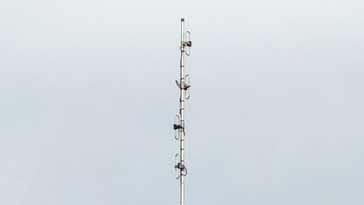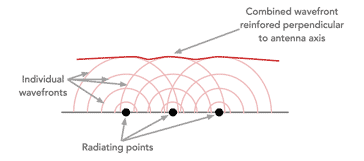Collinear Antenna
Collinear antennas are normally used as vertical antennas providing gain in the horizontal plane to provide the best all round coverage.
Home » Antennas & Propagation » this page
Phased array antennas includes:
Phased array antenna basics
Collinear antenna
Coaxial collinear
Beamforming & beamsteering antennas
A collinear antenna is a form of antenna that is normally vertical and it consists of a number of antenna elements, often dipoles mounted in such a manner that they are on a common axis - hence the name collinear or co-linear.
In fact a collinear antenna is one where two or more elements are arranged in the same axis, and in some instances even antennas like a 5/8λ, or half wave vertical antennas may be considered to be collinears, although the term is generally reserved for antennas where a number of specific elements are arranged in the same axis.

The individual antenna elements of the collinear are fed in such a fashion that a directive pattern is achieved. Normally the elements are all fed so that each antenna element radiates a signal of the same phase and as a result, the maximum radiation is at right angles to the axis of the antenna.
As the antenna is able to achieve a good directional pattern it is often used for broadcast transmissions, or for a point to point radio communications antenna as it is able to achieve all round coverage and with the main beam parallel to the earth's surface to gain the optimum coverage. It is found that less signal is radiated upwards where it is of no use.
In some instances the main beam may be directed down slightly so that local coverage is obtained. This may be particularly important for some broadcast stations that may have antennas mounted high on a tower.
Collinear antenna types
There are several ways in which collinear antennas can be realised. the basic collinear concept can be realised in a number of different ways according to what is required.
Whatever the type of collinear, they all follow the same basic concept of radiating elements on the same axis fed in the relevant phase signal to give the required.
The main types of collinear antenna are detailed below:
Collinear dipole array: One of the easiest methods of creating a collinear array is to stack vertical dipoles elements above each other. In this type of collinear antenna, the elements are fed by separate feed-lines but care needs to be taken in cutting their lengths to ensure that the required phasing is provided for each dipole.
Although a collinear is most commonly used as a vertical antenna, this is not always the case - it is possible to create horizontal dipole collinears where multiple half wavelength radiating elements are used. This radiate in a similar fashion to a standard horizontal dipole, but with a much narrower beamwidth.
Coaxial collinear antenna: The coaxial collinear is a convenient form of antenna which can be made using coaxial feedlines. For this type of antenna, the individual radiators have the centre conductor of one element connected electrically to the shield of the one above, and so on for as many elements are required.
The top element in the stack is a quarter-wave radiator connected directly to the centre conductor of the element below it.
This style of collinear antenna is often housed in a fibreglass tube which provides both support and structure to the antenna as well as giving environmental protection. These types of antenna are often made using coaxial cable and therefore it is very important to ensure that no moisture enters the cable otherwise losses will rise and the gain of the antenna will be lost and the performance may even become worse than that of a simple antenna with no gain.
Half wave monopole collinear: This type of collinear antenna array uses half-wavelength monopole elements with phasing coils between each consecutive pair of elements to achieve the necessary phase shift.
This approach can be less efficient than other types of collinear because the coils used for phasing introduce losses. However this style of antenna does not need the external protective and supporting tube required for most coaxial collinears. This type of collinear is generally only used for amateur radio applications.
There are many other types of antenna that fall into the category of being a collinear, but the ones mentioned above are the main types. These ones will be referred to as a collinear in the antenna description or specification.
Collinear antenna basics
The collinear antenna antenna is most commonly found these days as a vertical antenna with several elements stacked one above each other. However, it can also be used as a horizontal antenna - it could be considered very broadly as a directive form of dipole.
The basic idea is that several antenna elements that are arranged along the same axis are fed with the signal. care must be taken to ensure the phasing is right and this is normally arranged so that all the elements are driven in exactly the same phase.

With all the radiating elements (typically dipoles, etc) fed in phase the wavefronts moving away from the antenna elements will combined and constructively reinforce each other at right angles to the axis of the elements.
As the antennas are normally fed in phase on a collinear, this will mean that all the feed lines to the individual elements are of exactly the same length.
As the signals are all being transmitted from the individual antenna elements in the same phase they will constructively combine when the wavefront is travelling away from the antenna in a direction perpendicular to the antenna axis.

It will be found that as more elements are added, issues with sidelobes will start to rise, but these are not normally an issue for the main types of application for these antennas.
Collinear gain
The gain of a collinear antenna is dependent upon many factors, but the main one is the number of elements withint he antenna.
It is possible to calculate the maximum gain possible for collinear phased antennas for different numbers of elements.
| Collinear Gain vs Elements |
|
|---|---|
| Number of Elements | Maximum theoretical gain (dB) |
| 2 | 1.9 |
| 3 | 3.2 |
| 4 | 4.3 |
Note: collinear phased antennas with more than four elements are not normally designed and constructed so the gain levels for antennas up to four elements is given.
There are many different types of collinear antenna - some may not always be thought of as being collinear, but the term is very broad and can apply to a large number of antennas that may be considered to be other forms of antenna. Nevertheless, many collinear antennas are seen and more obviously fit into this category.
Collinears are used in many areas and can be a popular form of antenna where low angle, i.e. parallel to the Earth's surface and al all round or omnidirectional radiation pattern is needed. Broadcasters, mobile two way radio communications base stations and the like tend to use these antennas.
 Written by Ian Poole .
Written by Ian Poole .
Experienced electronics engineer and author.
More Antenna & Propagation Topics:
EM waves
Radio propagation
Ionospheric propagation
Ground wave
Meteor scatter
Tropospheric propagation
Antenna basics
Cubical quad
Dipole
Discone
Ferrite rod
Log periodic antenna
Parabolic reflector antenna
Phased array antennas
Vertical antennas
Yagi
Antenna grounding
Installation guidelines
TV antennas
Coax cable
Waveguide
VSWR
Antenna baluns
MIMO
Return to Antennas & Propagation menu . . .


